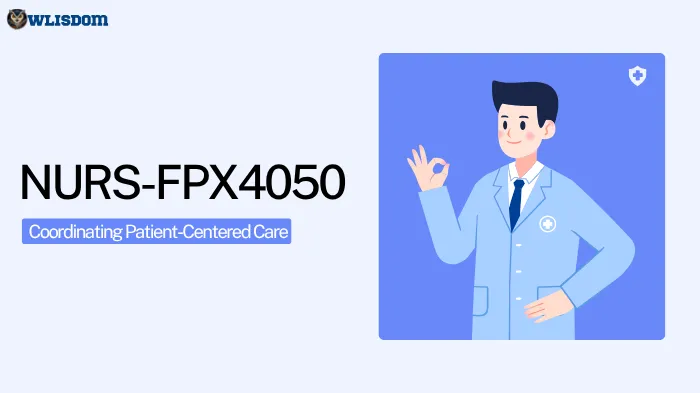NURS-FPX4050 – Coordinating Patient-Centered Care: Advancing Leadership, Collaboration, and Quality Outcomes in Nursing
Published: 2025-10-13
Modified: 2025-10-13
Samples Solutions
Introduction
NURS-FPX4050 – Coordinating Patient-Centered Care focuses on developing leadership and communication skills to improve patient outcomes through collaborative healthcare practices. The course emphasizes evidence-based decision-making, interprofessional teamwork, and quality improvement. For professional support with care coordination or nursing leadership assignments, visit Owlisdom’s Nursing Coursework Help.
NURS-FPX 4050 Assessment One: Preliminary Care Coordination Plan
Instructions for NURS-FPX 4050 Assessment One
Preliminary Care Coordination Plan
Develop a 3-4 page preliminary care coordination plan for a selected health care problem. Include physical, psychosocial, and cultural considerations for this health care problem. Identify and list available community resources for a safe and effective continuum of care.
Collapse All
Introduction
The first step in any effective project is planning. This assessment provides an opportunity for you to strengthen your understanding of how to plan and negotiate the coordination of care for a particular health care problem. Include physical, psychosocial, and cultural considerations for this health care problem. Identify and list available community resources for a safe and effective continuum of care.
NOTE: You are required to complete this assessment before Assessment 4.
Preparation
As you begin to prepare this assessment, you are encouraged to complete the Care Coordination Planning activity. Completion of this will provide useful practice, particularly for those of you who do not have care coordination experience in community settings. The information gained from completing this activity will help you succeed with the assessment. Completing formatives is also a way to demonstrate engagement.
Scenario
Imagine that you are a staff nurse in a community care center. Your facility has always had a dedicated case management staff that coordinated the patient plan of care, but recently, there were budget cuts and the case management staff has been relocated to the inpatient setting. Care coordination is essential to the success of effectively managing patients in the community setting, so you have been asked by your nurse manager to take on the role of care coordination. You are a bit unsure of the process, but you know you will do a good job because, as a nurse, you are familiar with difficult tasks. As you take on this expanded role, you will need to plan effectively to address the specific health concerns of community residents.
To prepare for this assessment, you may wish to:
- Review the assessment instructions and scoring guide to ensure that you understand the work you will be asked to complete.
- Allow plenty of time to plan your chosen health care concern.
Instructions
Note: You are required to complete this assessment before Assessment 4.
Develop the Preliminary Care Coordination Plan
Complete the following:
- Select one of the health concerns in the Assessment 01 Supplement: Preliminary Care Coordination Plan [PDF] Download Assessment 01 Supplement: Preliminary Care Coordination Plan [PDF]resource as the focus of your care coordination plan. In your plan, please include physical, psychosocial, and cultural needs.
- Identify available community resources for a safe and effective continuum of care.
Document Format and Length
- Your preliminary plan should be an APA scholarly paper, 3–4 pages in length.
- Remember to use active voice, which means being direct and writing concisely, as opposed to passive voice, which means writing with a tendency to wordiness.
- In your paper, include possible community resources that can be used.
- Be sure to review the scoring guide to make sure all criteria are addressed in your paper.
- Study the subtle differences between basic, proficient, and distinguished.
Supporting Evidence
Cite at least two credible sources from peer-reviewed journals or professional industry publications that support your preliminary plan.
Grading Requirements
The requirements, outlined below, correspond to the grading criteria in the Preliminary Care Coordination Plan Scoring Guide, so be sure to address each point. Read the performance-level descriptions for each criterion to see how your work will be assessed.
- Analyze your selected health concern and the associated best practices for health improvement.
- Cite supporting evidence for best practices.
- Consider underlying assumptions and points of uncertainty in your analysis.
- Describe specific goals that should be established to address the health care problem.
- Identify available community resources for a safe and effective continuum of care.
- Organize content so ideas flow logically with smooth transitions; contains few errors in grammar/punctuation, word choice, and spelling.
- Apply APA formatting to in-text citations and references, exhibiting nearly flawless adherence to APA format.
- Write with a specific purpose with your patient in mind.
- Adhere to scholarly and disciplinary writing standards and current APA formatting requirements.
Additional Requirements
Before submitting your assessment, proofread your preliminary care coordination plan and community resources list to minimize errors that could distract readers and make it more difficult for them to focus on the substance of your plan. Be sure to submit both documents.
Portfolio Prompt: Save your presentation to your ePortfolio.
Course Competencies
By successfully completing this assessment, you will demonstrate your proficiency in the following course competencies and scoring guide criteria:
- Competency 1: Adapt care based on patient-centered and person-focused factors.
- Analyze a health concern and the associated best practices for health improvement.
- Competency 2: Collaborate with patients and family to achieve desired outcomes.
- Describe specific goals that should be established to address a selected health care problem.
- Competency 3: Create a satisfying patient experience.
- Identify available community resources for a safe and effective continuum of care.
- Competency 6: Apply professional, scholarly communication strategies to lead patient-centered care.
- Organize content so ideas flow logically with smooth transitions; contains few errors in grammar/punctuation, word choice, and spelling.
- Apply APA formatting to in-text citations and references, exhibiting nearly flawless adherence to APA format.
Introduction to NURS-FPX 4050 Assessment One: Preliminary Care Coordination Plan
The NURS-FPX 4050 Assessment One: Preliminary Care Coordination Plan. One involves developing a preliminary care coordination plan for a selected healthcare problem. As part of this task, you will include physical, psychosocial, and cultural considerations and identify community resources for a safe and effective continuum of care. This How-To NURS-FPX 4050 Owlisdom Guide will provide step-by-step instructions to help you complete each part of the assignment professionally and effectively.
Selecting a Health Concern in NURS-FPX 4050 Assessment One: Preliminary Care Coordination Plan
We will choose one of the two topics given to start the NURS-FPX 4050 ASSESSMENT ONE: Preliminary Care Coordination Plan.
- Review the “Assessment 01 Supplement: Preliminary Care Coordination Plan” to choose a health concern.
- Ensure the selected health concern is relevant and has sufficient data for analysis.
Example
For the NURS 4050 Assessment One, I am choosing:
Lack of Access to Healthcare Services
- Physical considerations: Limited transportation options, long wait times for appointments, and lack of insurance coverage can prevent individuals from accessing healthcare services.
- Psychosocial considerations: Fear of medical procedures, mistrust of healthcare providers, and language barriers can also prevent individuals from accessing healthcare services.
- Cultural considerations: Cultural beliefs and practices may influence an individual’s willingness to seek medical care.
- Community resources: Community health clinics, mobile health clinics, and telehealth services can provide accessible healthcare services to individuals who may not have access to traditional healthcare settings.
Analyzing the Health Concern
Next, we will analyze the concepts.
- Research the health concern thoroughly, focusing on current best practices for health improvement.
- Look for credible sources such as peer-reviewed journals, official health organization reports, and academic texts.
- Physical Needs: Consider the medical and physical requirements of patients with the chosen health concern.
- Psychosocial Needs: Identify the psychological and social factors affecting patients, such as mental health and social support systems.
- Cultural Needs: Understand the cultural backgrounds and specific cultural needs that may impact patient care.
Example
Healthcare service barriers can be categorized into three main types: cultural, psychological, and physical. Physically, individuals face difficulties due to limited transportation options, making it hard to reach medical facilities. Additionally, long wait times for appointments further discourage people from seeking necessary medical care. Lack of insurance is a significant barrier, especially for those with limited financial resources.
Psychosocial barriers also significantly impact access. Fear of medical procedures often prevents individuals from seeking timely care. Similarly, distrust of healthcare providers, which may arise from systemic issues or previous negative experiences, can lead to reluctance to use healthcare services (McMaughan et al., 2020). Language barriers add to the challenges faced by those with limited English proficiency, hindering effective communication of their healthcare needs.
Cultural factors play a crucial role in how individuals approach medical care. Cultural beliefs and traditions shape people’s willingness to utilize services and affect their perceptions of illness and healthcare (Allen et al., 2024). To enhance healthcare service accessibility across diverse populations, it is essential to understand and address these cultural influences.
Identifying Community Resources
Now, we will discuss the identification I of the community resources.
- Research available community resources that can support the continuum of care.
- Include resources such as local clinics, support groups, social services, and non-profit organizations.
Example
Utilizing community resources is crucial for addressing healthcare service accessibility and ensuring a safe and efficient continuum of care. Community health clinics serve as accessible centers for primary care, providing comprehensive healthcare to all individuals, regardless of their insurance status (Allen et al., 2024). Additionally, mobile health clinics are effective in delivering essential medical services to underserved regions, reaching out to disadvantaged populations.
Telehealth services offer a convenient alternative for those facing barriers such as lack of transportation or remote locations, enabling online consultations with medical professionals. Moreover, community organizations and nonprofits often provide support services, such as financial counseling, language interpretation, and transportation assistance, to help individuals overcome obstacles to accessing healthcare (Allen et al., 2024). By leveraging these diverse community resources, healthcare organizations can promote equitable healthcare delivery and reduce disparities in access to care for all community members.
Setting Specific Goals
For this section of the NURS 4050, we will explore setting up specific goals.
- Establish clear, measurable, and achievable goals to address the selected healthcare problem.
- Goals should be specific to the health concern and consider physical, psychosocial, and cultural needs.
Example
To effectively tackle the issue of healthcare service accessibility, it is essential to establish achievable, measurable, and realistic goals. These goals should encompass initiatives such as reducing appointment wait times by a specific percentage within a set timeframe, increasing the number of patients utilizing telehealth services, and offering more transportation options for individuals with limited mobility.
Ensuring that these objectives are patient-centered and aligned with desired outcomes is equally important. This involves engaging the community in the goal-setting process, understanding their unique needs and preferences, and tailoring interventions accordingly. Patient-centered goals may include increasing participation in preventive health programs, reducing healthcare access disparities among underserved populations, and improving patient satisfaction with access to care (McMaughan et al., 2020). By prioritizing patient-centeredness and alignment with desired outcomes, the care coordination plan can effectively address the underlying issues contributing to the community’s limited access to healthcare services.
Demonstration of Proficiency
Competency 1: Adapt care based on patient-centered and person-focused factors.
Competency 2: Collaborate with patients and families to achieve desired outcomes.
Competency 3: Create a satisfying patient experience.
Competency 6: Apply professional, scholarly communication strategies to lead patient-centered care.
Closing
In NURS-FPX 4050 ASSESSMENT ONE: Preliminary Care Coordination Plan, you will create a comprehensive care coordination plan that addresses the physical, psychosocial, and cultural needs of a selected healthcare problem. Identifying community resources and setting specific goals are crucial steps. Ensuring the content is well-organized and formatted according to APA standards will enhance the quality of your work.
Reference
Allen, L. N., Karanja, S., Tlhakanelo, J., Macleod, D., Tlhajoane, M., & Bastawrous, A. (2024). Comparison of telephone and in-person interview modalities: Duration, richness, and costs in the context of exploring determinants of equitable access to community health services in Meru, Kenya (p. 2024.03.13.24304203). medRxiv. https://doi.org/10.1101/2024.03.13.24304203
McMaughan, D. J., Oloruntoba, O., & Smith, M. L. (2020). Socioeconomic Status and Access to Healthcare: Interrelated Drivers for Healthy Aging. Frontiers in Public Health, 8. https://doi.org/10.3389/fpubh.2020.00231
NURS-FPX 4050 ASSESSMENT TWO
Instructions for NURS-FPX 4050 Assessment Two
Ethical and Policy Factors in Care Coordination
This course has been completed and no further assessments may be submitted.
Use the resources linked below to help complete this assessment.
Collapse All
Care Coordination Fundamentals
You may review the resources on the following reading list:
- Assessment 1: Care Coordination Fundamentals reading list.
Academic Resources
A variety of writing resources are available in the NHS Learner Support Lab, linked in the course room navigation menu.
Scholarly Writing and APA Style
Use the following resources to improve your writing skills and find answers to specific questions.
Library Research
Use the following resources to help with any required or self-directed research you do to support your coursework.
- BSN Program Library Research Guide.
- Capella University Library.
- Journal and Book Locator Library Guide.
- Library Research and Information Literacy Skills.
- NURS-FPX4050: Coordinating Patient-Centered Care Library Guide.
Writing SMART Goals for Care Coordination
During care coordination, nurses should ensure that they are creating patient-centered goals. A great way to achieve this is by using SMART (Specific, Measurable, Attainable, Relevant, Timely) goals. SMART goals provide direction for patient-centered care coordination.
SMART goals must be effective, meaningful, achievable, and collaborative in nature. Key stakeholders (such as the individual, group, or community; possibly significant others; and you, the nurse) must be taken into account.
Often, the best way to achieve patient-centered functional goals is simply to ask the target group, “What are your goals?” Doing this will help you to improve adherence, satisfaction, and outcomes. Consider the following when developing SMART goals:
- Specific: Goals will specify who will be responsible, what is to be achieved, where the activity is located, and why it is important or beneficial.
- Measurable: Goals must specify criteria for measuring progress against them. This helps you to stay on track, reach milestones, and motivate the stakeholders.
- Attainable: Setting attainable goals serves to motivate the individual or group.
- Relevant: Key stakeholders must see how a specific goal is relevant to them.
- Timely: To be most effective, goals must be structured around a specific time frame to motivate individuals to begin working on their goals.
After developing a mutually agreed-upon goal, SMART objectives are developed to help guide activities. Objectives help to determine whether the goals have been achieved and if revisions need to be made for future educational sessions.
SMART objectives must be:
- Specific: Objectives need to be concrete, detailed, and well-defined so that you know exactly what is going to occur and what to expect.
- Measurable: A way to determine how the goal was met or if it needs revision.
- Achievable: The objective must be appropriate and feasible for those involved. Ask: What’s the patient’s learning style? For example, does the patient prefer reading printed materials, viewing audiovisual materials, or watching demonstrations?
- Realistic: It must take into consideration constraints such as resources, personnel, cost, education level, learning style, reading level and comprehension level. What language do they speak? How much does the individual or group like to know? Ask: Can the patient read or comprehend instructions or follow directions? Do they prefer reading printed materials, viewing audiovisual materials, or demonstrations?
- Time-bound: A time frame helps set boundaries around the objective. Ask: How long will it take to obtain the objective? Objectives may be process- or outcome-oriented.
Outcome objectives can be short-term, intermediate, or long-term:
- Short-term objectives can be achieved after implementing certain activities or interventions. Change may be in cognitive (knowledge), psychomotor (demonstration), and values (attitude).
- Intermediate outcome objectives provide a sense of progress toward reaching long-term objectives. This could be a behavior and policy change.
- Long-term objectives occur after the program has been implemented. It may take more than a month. These can be changes in mortality, morbidity, and quality of life.
Example of a SMART goal:
- Walk for 30 minutes a day, seven days a week.
Example of a SMART objective:
- By the end of the week, the patient will have walked 3.5 hours.
Example of an evaluation of a SMART objective:
- The patient will complete a daily log of miles each week.
Additional Resources
The additional resources on the following reading list will help you in establishing SMART goals and objectives in collaboration with educational session participants:
- Assessment 1: Writing SMART Goals for Care Coordination reading list.
Additional Resources for Further Exploration
You may use the following resource to further explore topics related to the competencies.
ACTIVITY
This course has been completed, and no further assessments may be submitted.
A key aspect of the care coordination process is effective planning that answers the following questions:
- What is the best approach to planning for care?
- What are the essential steps in the process?
Complete the Care Coordination Planning activity to gain insight into the most important considerations when preparing to develop a care coordination plan.
This tool needs to be loaded in a new browser window
Introduction to NURS 4050 Assessment Two
The NURS-FPX 4050 Assessment Two requires you to develop a presentation on ethical and policy issues in care coordination, specifically within the context of cancer care provided by the American Cancer Society (ACS). This How-To NURS 4050 Guide will address various aspects, including the ACS’s mission, the significance of ethical and policy considerations, the impact of governmental policies, and key ethical dilemmas in cancer care coordination.
Overview of the American Cancer Society (ACS)
To start the NURS 4050 Assessment Two, we will discuss the overview of the ACS.
- Introduce the ACS by detailing its mission and goals, emphasizing its dedication to eliminating cancer as a significant health issue.
- Mention the support and advocacy services ACS provides, such as counseling, financial assistance, and policy advocacy.
Example
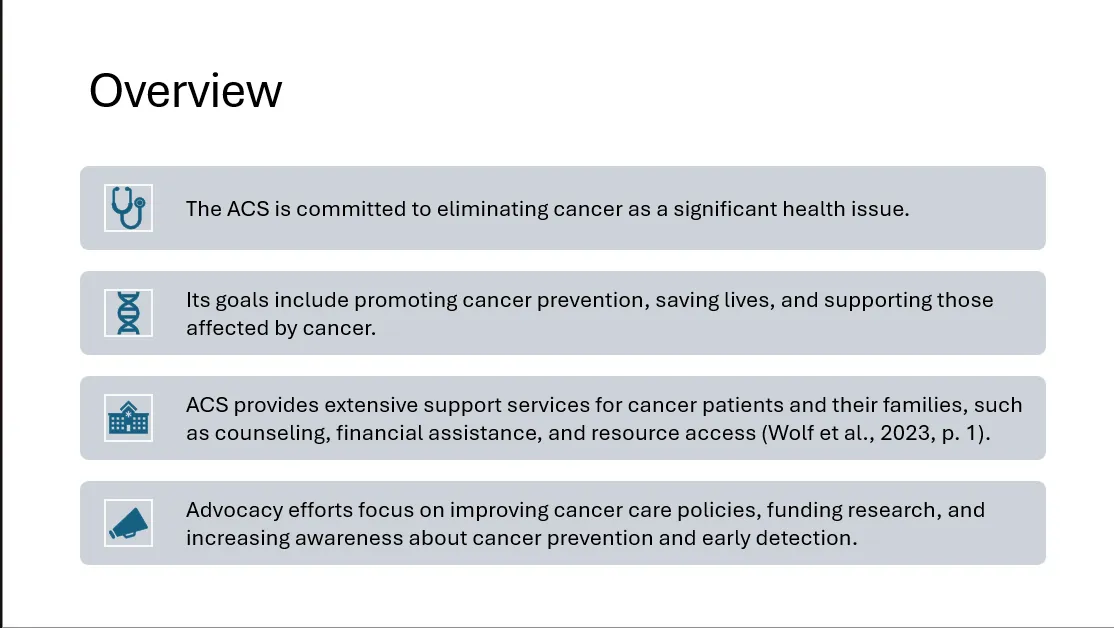
Importance of Ethical and Policy Considerations
Next, we will explore the importance of the ethical and policy considerations.
- Explain why ethical considerations are crucial for upholding patient rights, dignity, and autonomy in care coordination.
- Discuss how policy considerations guide decision-making and resource allocation, ensuring consistent and accountable care delivery.
Example
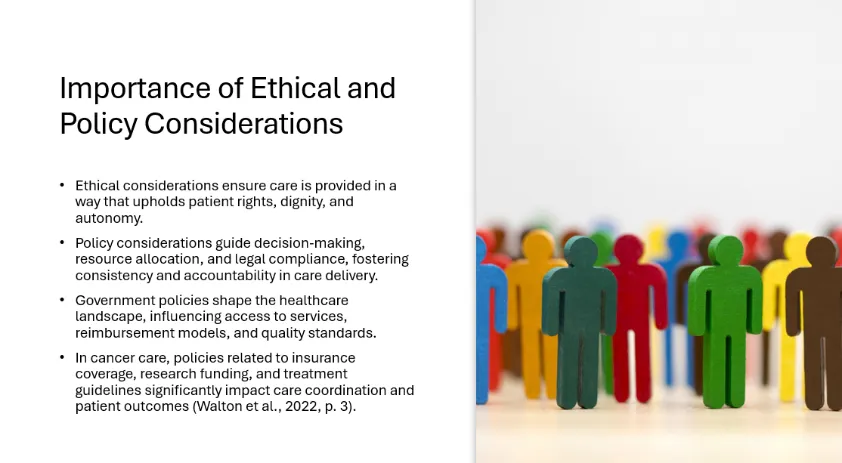
Analyzing Policy Impact on Cancer Care
This section of the NURS 4050 Assessment explores the analysis of policy impact on cancer care.
- Analyze how specific policies, such as the Affordable Care Act (ACA), Medicare reimbursement policies, and FDA regulations, impact cancer care.
- Highlight examples like Medicaid expansion, preventive service coverage, and drug approval processes.
Example

Addressing Ethical Dilemmas in Care Coordination
Here, let us discuss the ethical dilemmas in care coordination.
- Identify and discuss critical ethical dilemmas, such as patient confidentiality, equitable access to care, and end-of-life decisions.
- Explain how national, state, and local policies influence these ethical challenges.
Example
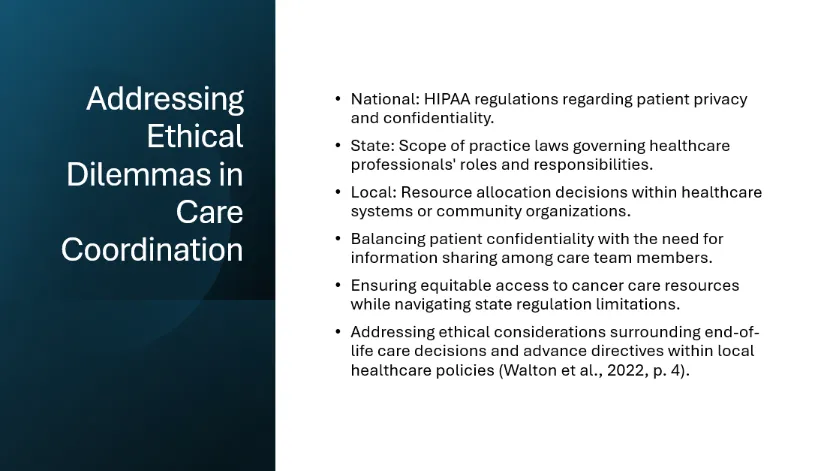
Influence of the Code of Ethics for Nurses
- Describe the impact of the Code of Ethics for Nurses on cancer care coordination.
- Emphasize the importance of patient advocacy, collaboration, respect for patient autonomy, and maintaining confidentiality within the care team.
Example
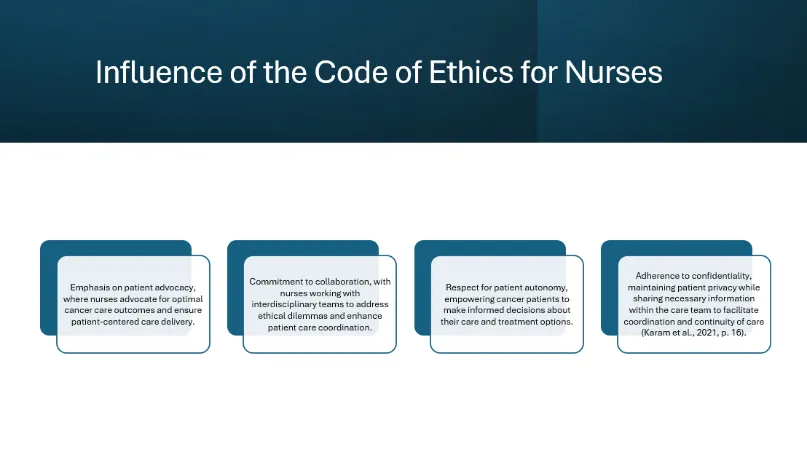
Role of Social Determinants of Health
Here, we will discuss the role of social determinants of health.
- Discuss how social determinants of health, such as socioeconomic status, access to healthcare, and education, affect cancer care coordination.
- Explain the relevance of the Healthy People 2020 framework and interventions that address these determinants.
Example
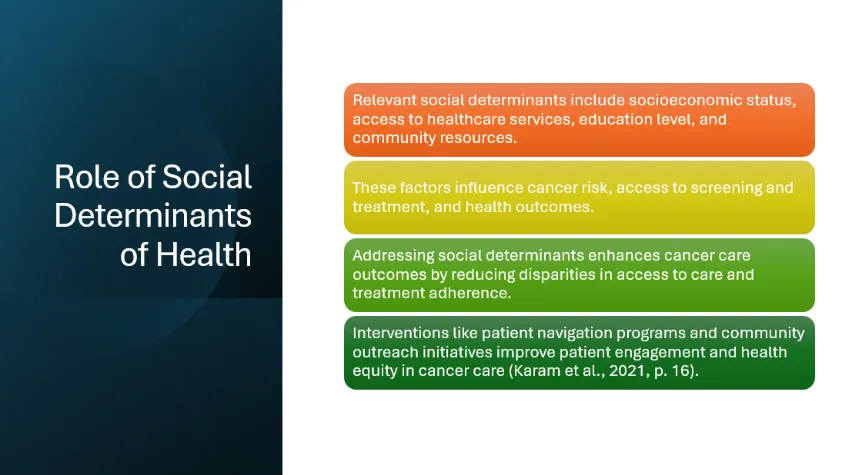
Key Ethical and Policy Issues
- Summarize critical ethical issues, such as informed consent, equity in access, end-of-life care, and policy issues like insurance coverage and regulatory compliance.
- Use these points to illustrate the complexities in cancer care coordination.
Formulating Recommendations for Action
At the end, we will formulate recommendations for the action.
- Based on your analysis, provide actionable recommendations.
- Suggest implementing patient navigation programs, advocating for policy changes, and strengthening interdisciplinary collaboration to improve cancer care coordination.
Example
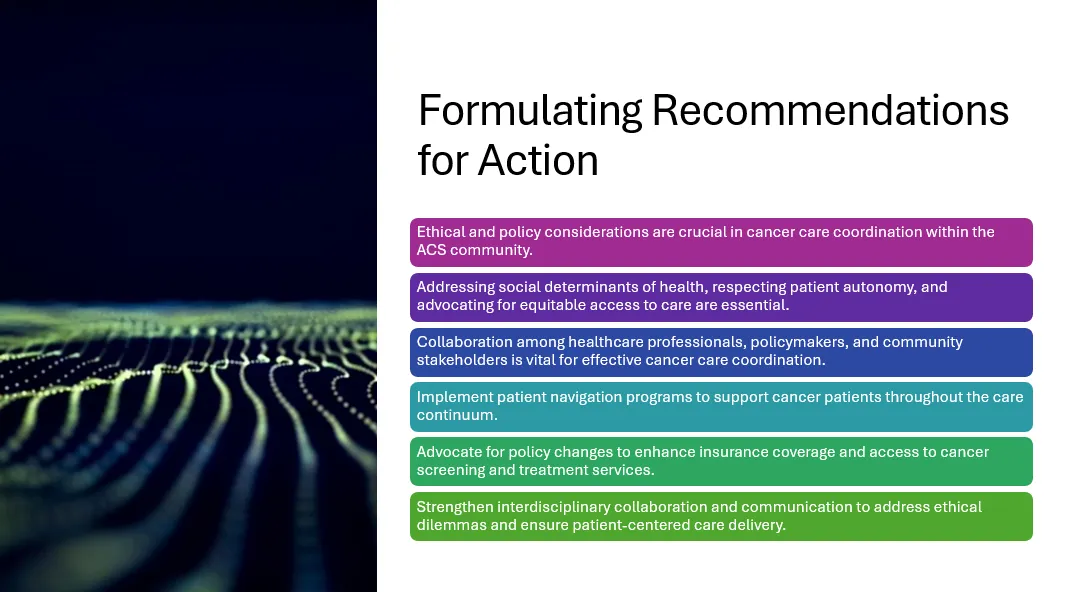
Demonstration of Proficiency
Competency 4: Defend decisions based on the code of ethics for nursing.
Competency 5: Explain how healthcare policies affect patient-centered care.
Competency 6: Apply professional, scholarly communication strategies to lead patient-centered care.
Closing
In NURS 4050 Assessment Two, you have explored the ethical and policy issues in cancer care coordination within the ACS context. By following these guidelines, you can effectively highlight the significance of ethical and policy considerations, analyze the impact of specific policies, address vital ethical dilemmas, and propose actionable recommendations for improving cancer care coordination.
Reference
Carter, S. M., Rogers, W., Win, K. T., Frazer, H., Richards, B., & Houssami, N. (2020). The ethical, legal, and social implications of using artificial intelligence systems in breast cancer care. Breast (Edinburgh), 49, 25–32. https://doi.org/10.1016/j.breast.2019.10.001
Karam, M., Chouinard, M., Poitras, M., Couturier, Y., Vedel, I., Grgurevic, N., & Hudon, C. (2021). Nursing Care Coordination for Patients with Complex Needs in Primary Healthcare: A Scoping Review. International Journal of Integrated Care, 21(1), 16. https://doi.org/10.5334/ijic.5518
Walton, H., Simpson, A., Ramsay, A. M., Hunter, A., Jones, J., Ng, P. L., Leeson‐Beevers, K., Bloom, L., Kai, J., Kokocinska, M., Sutcliffe, A., Morris, S., & Fulop, N. (2022). Development of models of care coordination for rare conditions: a qualitative study. Orphanet Journal of Rare Diseases, 17(1). https://doi.org/10.1186/s13023-022-02190-3
Wolf, A. M. D., Oeffinger, K. C., Shih, Y. C. T., Walter, L. C., Church, T. R., Fontham, E. T., Elkin, E. B., Etzioni, R., Guerra, C. E., Perkins, R. B., Kondo, K., Kratzer, T. B., Manassaram‐Baptiste, D., Dahut, W. L., & Smith, R. A. (2023). Screening for lung cancer: 2023 guideline update from the American Cancer Society. CA: A Cancer Journal for Clinicians. https://doi.org/10.3322/caac.21811
NURS-FPX 4050 Assessment Three: Care Coordination Presentation to Colleagues
Instructions for NURS-FPX 4050 Assessment Three
Care Coordination Presentation to Colleagues
Develop a 20-minute video presentation for nursing colleagues highlighting the fundamental principles of care coordination. Create a detailed narrative script for your presentation, approximately 4-5 pages in length. This is a video presentation.
Collapse All
Introduction
This assessment provides an opportunity for you to educate your peers on the care coordination process. The assessment also requires you to address change management issues.
Preparation
You are encouraged to complete the Managing Change activity. Completing course activities before submitting your first attempt has been shown to make the difference between basic and proficient assessment.
Scenario
Your nurse manager has been observing your effectiveness as a care coordinator and recognizes the importance of educating other staff nurses in care coordination. Consequently, she has asked you to develop a presentation for your colleagues on care coordination basics. By providing them with basic information about the care coordination process, you will assist them in taking on an expanded role in helping to manage the care coordination process and improve patient outcomes in your community care center.
To prepare for this assessment, identify key factors nurses must consider to effectively participate in the care coordination process.
You may also wish to:
- Review the assessment instructions and scoring guide to ensure you understand the work you will be asked to complete.
- Allow plenty of time to rehearse your presentation.
Recording Equipment Setup and Testing
Check that your recording equipment and software are working properly and that you know how to record and upload your presentation. You may use Kaltura (recommended) or similar software for your audio recording. A reference page is required. However, no PowerPoint presentation is required for this assessment.
- If using Kaltura, refer to the Using Kaltura tutorial for directions on recording and uploading your video in the course room.
Instructions
Complete the following:
- Develop a video presentation for nursing colleagues highlighting the fundamental principles of care coordination. Include community resources, ethical issues, and policy issues that affect the coordination of care. To prepare, develop a detailed narrative script. The script will be submitted along with the video.
Note: You are not required to deliver your presentation.
Presentation Format and Length
Create a detailed narrative script for your video presentation, approximately 4–5 pages in length. Include a reference list at the end of the script.
Supporting Evidence
Cite 3–5 credible sources from peer-reviewed journals or professional industry publications to support your video. Include your source citations on a references page appended to your narrative script. Explore the resources about effective presentations as you prepare your assessment.
Grading Requirements
The requirements outlined below correspond to the grading criteria in the Care Coordination Presentation to Colleagues Scoring Guide, so be sure to address each point. Read the performance-level descriptions for each criterion to see how your work will be assessed.
- Outline effective strategies for collaborating with patients and their families to achieve desired health outcomes.
- Provide, for example, drug-specific educational interventions, cultural competence strategies.
- Include evidence that you have to support your selected strategies.
- Identify the aspects of change management that directly affect elements of the patient experience essential to the provision of high-quality, patient-centered care.
- Explain the rationale for coordinated care plans based on ethical decision-making.
- Consider the reasonable implications and consequences of an ethical approach to care and any underlying assumptions that may influence decision-making.
- Identify the potential impact of specific health care policy provisions on outcomes and patient experiences.
- What are the logical implications and consequences of relevant policy provisions?
- What evidence do you have to support your conclusions?
- Raise awareness of the nurse’s vital role in the coordination and continuum of care in a video-recorded presentation.
- Fine tune the presentation to your audience.
- Stay focused on key issues of import with respect to the effects of resources, ethics, and policy on the provision of high-quality, patient-centered care.
- Adhere to presentation best practices.
Additional Requirements
Submit both your presentation video and script. The script should include a reference page. See Using Kaltura for more information about uploading multimedia files. You may submit the assessment only once, so be sure that both assessment deliverables are included.
Portfolio Prompt: Save your presentation to your ePortfolio. Submissions to the ePortfolio will be part of your final Capstone course.
Context
Nurses have a powerful role in the coordination and continuum of care. All nurses must be cognizant of the care coordination process and how safety, ethics, policy, physiological, and cultural needs affect care and patient outcomes. As a nurse, care coordination is something that should always be considered. Nurses must be aware of factors that impact care coordination and of a continuum of care that utilizes community resources effectively and is part of an ethical framework that represents the professionalism of nurses. Understanding policy elements helps nurses coordinate care effectively.
Course Competencies
By successfully completing this assessment, you will demonstrate your proficiency in the following course competencies and scoring guide criteria:
- Competency 2: Collaborate with patients and family to achieve desired outcomes.
- Outline effective strategies for collaborating with patients and their families to achieve desired health outcomes.
- Competency 3: Create a satisfying patient experience.
- Identify the aspects of change management that directly affect elements of the patient experience essential to the provision of high-quality, patient-centered care.
- Competency 4: Defend decisions based on the code of ethics for nursing.
- Explain the rationale for coordinated care plans based on ethical decision making.
- Competency 5: Explain how health care policies affect patient-centered care.
- Identify the potential impact of specific health care policy provisions on outcomes and patient experiences.
- Competency 6: Apply professional, scholarly communication strategies to lead patient-centered care.
- Raise awareness of the nurse’s vital role in the coordination and continuum of care in a video-recorded presentation.
RESOURCES
This course has been completed and no further assessments may be submitted.
Use the resources linked below to help complete this assessment.
Collapse All
Care Coordination
As you read through the articles on the following reading list, it is important to consider how you can convey the principles of care coordination clearly to your colleagues. Remember that some staff nurses and nursing managers may feel more comfortable focusing on direct patient care and completing tasks while turning over care coordination to social workers and case or care managers. However, care coordination belongs to all nurses, and changing health care systems, legislation, and budgetary restrictions are placing staff nurses in roles where they are more involved or lead care coordination. As a BSN nurse, it is your role to assist and lead care coordination and determine how you can help nursing colleagues understand care coordination as a powerful way to improve patient outcomes.
- Assessment 3: Care Coordination reading list.
Multimedia Recording and Academic Resources
A variety of writing resources are available in the NHS Learner Support Lab, linked in the courseroom navigation menu.
Effective Presentations
The following resources will help you create and deliver an effective presentation.
- Conquering Death by PowerPoint: The Seven Rules of Proper Visual Design.
- This video is a primer on presentation design.
- Approximate run time: 45:00
- Creating a Presentation: A Guide to Writing and Speaking.
- This video addresses the primary areas involved in creating effective audiovisual presentations. You can return to this resource throughout the process of creating your presentation to view the tutorial appropriate for you at each stage.
- Microsoft Office Software.
- This Campus resource includes tip sheets and tutorials for Microsoft PowerPoint.
- PowerPoint Presentations Library Guide.
- This library guide provides links to PowerPoint and other presentation software resources.
- SoNHS Professional Presentation Guidelines [PPTX].
- This presentation is designed as a model to help you develop professional-quality PowerPoint presentations.
Scholarly Writing and APA Style
Use the following resources to improve your writing skills and find answers to specific questions.
Library Research
Use the following resources to help with any required or self-directed research you do to support your coursework.
- BSN Program Library Research Guide.
- Capella University Library.
- Journal and Book Locator Library Guide.
- Library Research and Information Literacy Skills
- NURS-FPX4050: Coordinating Patient-Centered Care Library Guide.
ePortfolio
Use the following resource to understand how to save your assessments to ePortfolio:
Additional Resources for Further Exploration
You may use the resources on the following reading list to further explore topics related to the competencies. They will help you to think about the connection between patient care and care coordination.
ACTIVITY
This course has been completed and no further assessments may be submitted.
Care coordination occurs in a rapidly evolving health care system. Today’s resources and policies may not be available or applicable tomorrow. Patient goals today will change and evolve over time. Because nurses work in a changing environment, they must be familiar with change management and strategies for dealing effectively with change. As a care coordinator, you will need to understand how to manage change.
Complete the Managing Change activity to gain insight into the importance of being able to effectively manage change.
This tool needs to be loaded in a new browser window
Introduction to NURS 4050 Assessment Three
This How-To NURS-FPX 4050 Owlisdom Guide is designed to help you develop a 20-minute video presentation for your nursing colleagues, focusing on the fundamental principles of care coordination. For NURS-FPX 4050 Assessment Three: Care Coordination Presentation to Colleagues, you will create a narrative script of approximately 4-5 pages to educate your peers on the care coordination process. This How-To Guide will provide step-by-step instructions to help you effectively prepare and deliver your presentation, ensuring you address all necessary components, including change management and ethical decision-making in care coordination.
Outline effective collaboration strategies for patients and their families to achieve desired health outcomes.Provide, for example, drug-specific educational interventions and cultural competence strategies.Include evidence that you have to support your selected strategies.
Effective Strategies for Collaborating with Patients and Families
To start the NURS 4050 Assessment Three, we will discuss the effective strategies for collaborating with patients and their families.
1. Drug-Specific Educational Interventions
- Research and include evidence-based educational interventions tailored to specific medications.
- Emphasize the importance of medication adherence and potential side effects.
- Provide resources such as pamphlets, apps, or follow-up consultations.
2. Cultural Competence Strategies
- Learn about the cultural backgrounds of your patients to provide culturally sensitive care.
- Use interpreters and culturally relevant educational materials when necessary.
- Respect cultural preferences in treatment plans and communicate effectively with family members.
Example
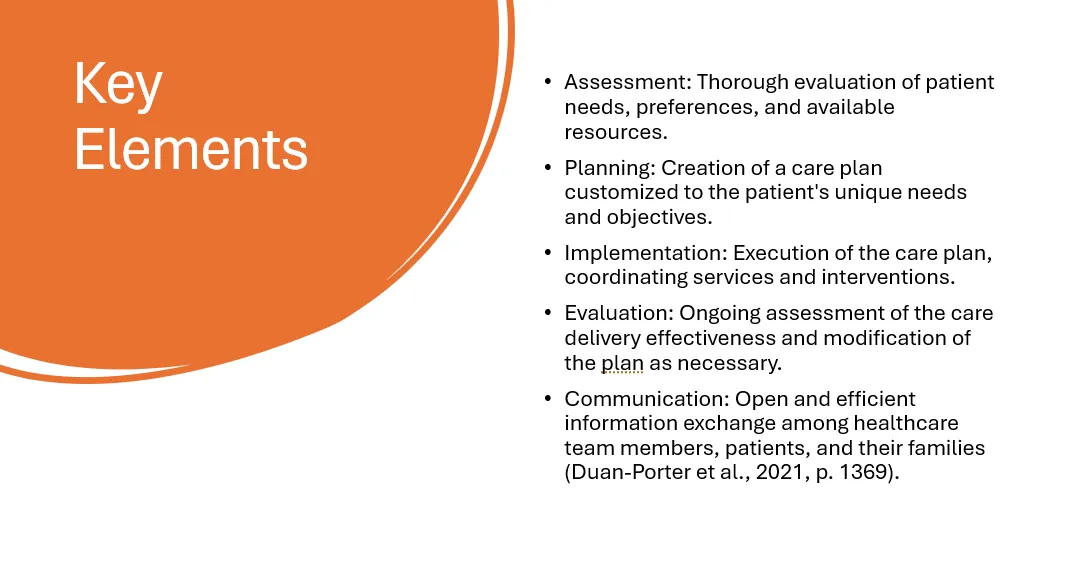
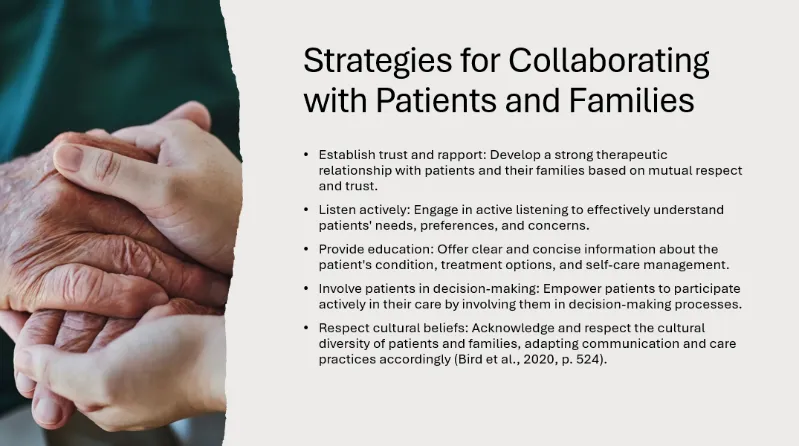
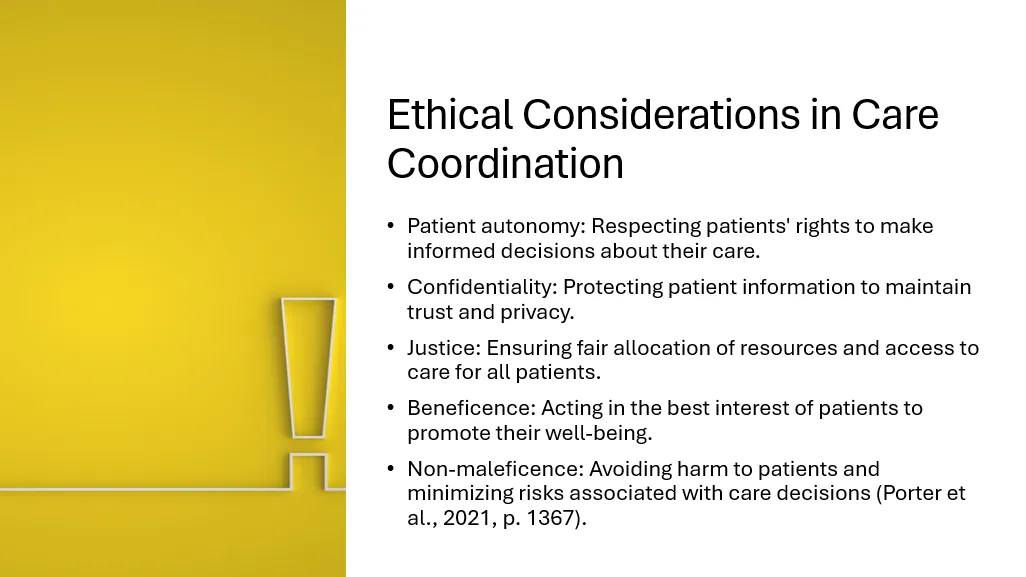
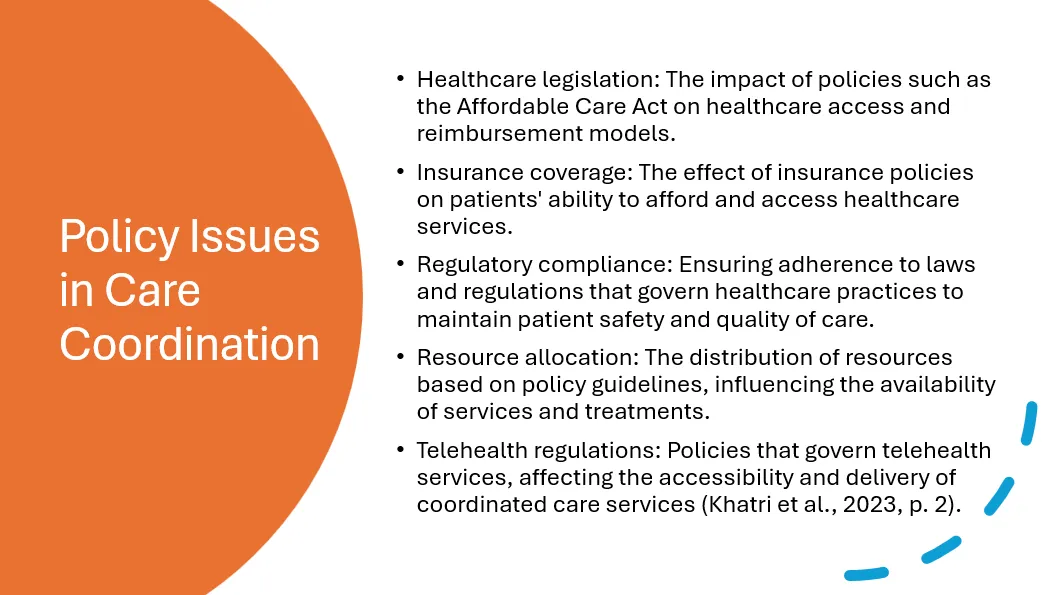
Identify the aspects of change management that directly affect elements of the patient experience, which is essential to providing high-quality, patient-centered care.
Change Management and Its Impact on Patient Experience
Next, we will explore change management and its impact on patients’ experience.
1. Identify Key Change Management Aspects
- Highlight aspects such as communication, training, and stakeholder involvement.
- Discuss how these elements influence patient experience and outcomes.
- Provide real-world examples of successful change management in healthcare settings.
2. Implement Change Management Strategies
- Develop strategies for effectively managing change within your care coordination process.
- Focus on continuous improvement and adaptability to enhance patient-centered care.
Example
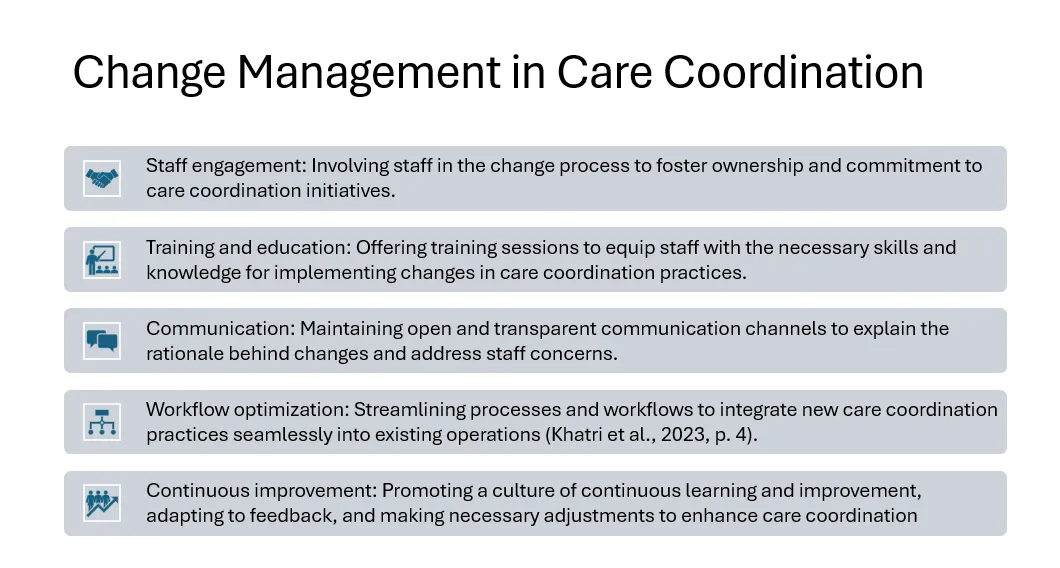
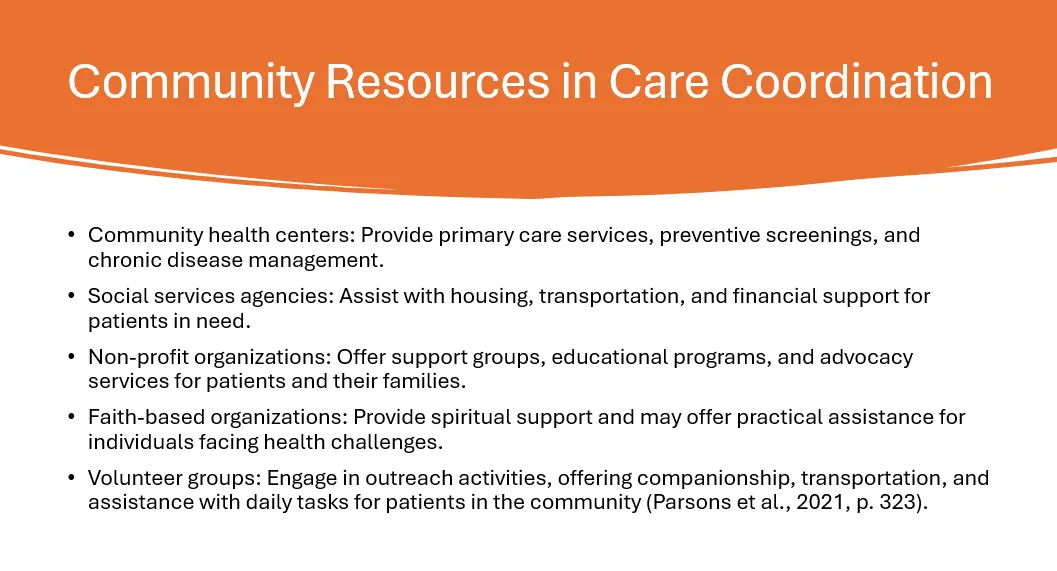
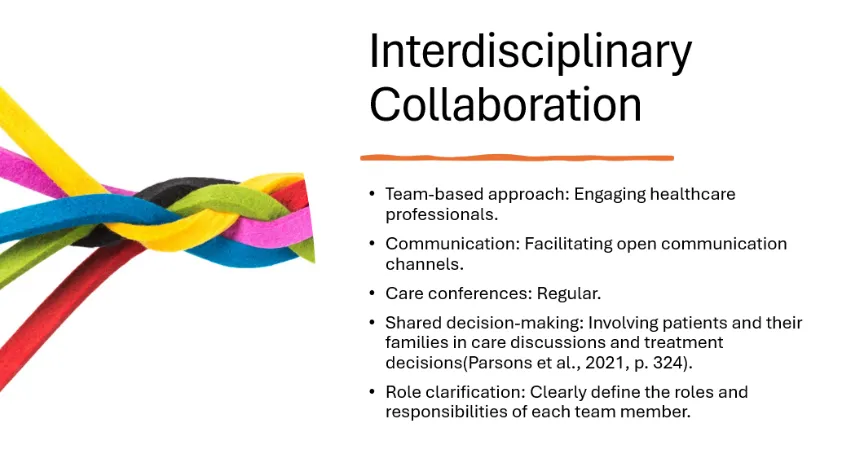
Explain the rationale for coordinated care plans based on ethical decision-making.Consider the reasonable implications and consequences of an ethical approach to care and any underlying assumptions that may influence decision-making.
Rationale for Coordinated Care Plans Based on Ethical Decision-Making
Here, we will discuss the rationale for coordinated care plans.
1. Ethical Decision-Making Frameworks
- Explain the principles of ethical decision-making in nursing, such as autonomy, beneficence, and justice.
- Discuss how these principles guide the development of coordinated care plans.
- Consider the implications and consequences of ethical decisions on patient care.
2. Addressing Ethical Dilemmas
- Provide examples of common ethical dilemmas in care coordination.
- Offer strategies for resolving these dilemmas while maintaining high ethical standards.
Example
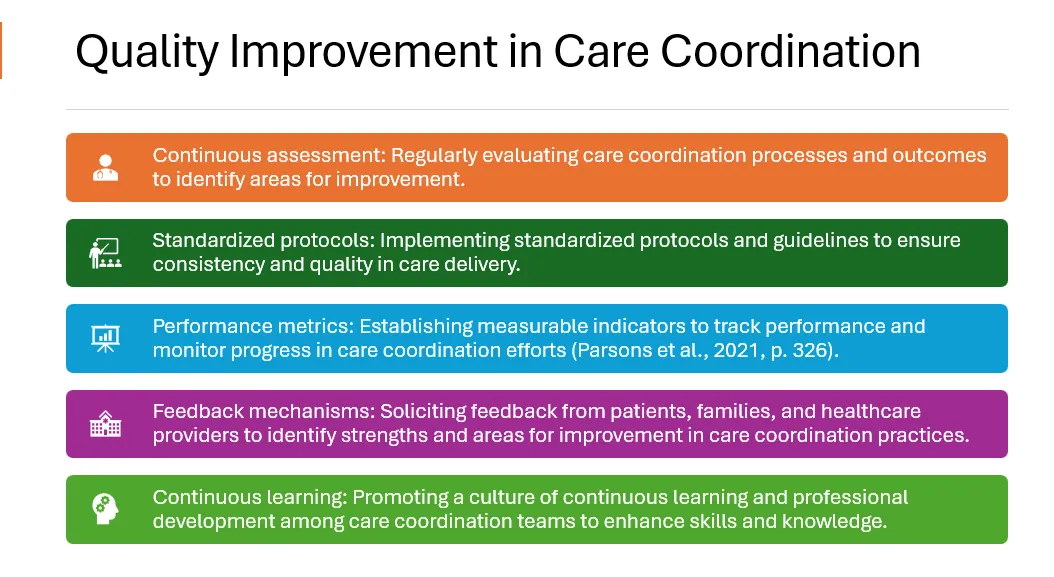
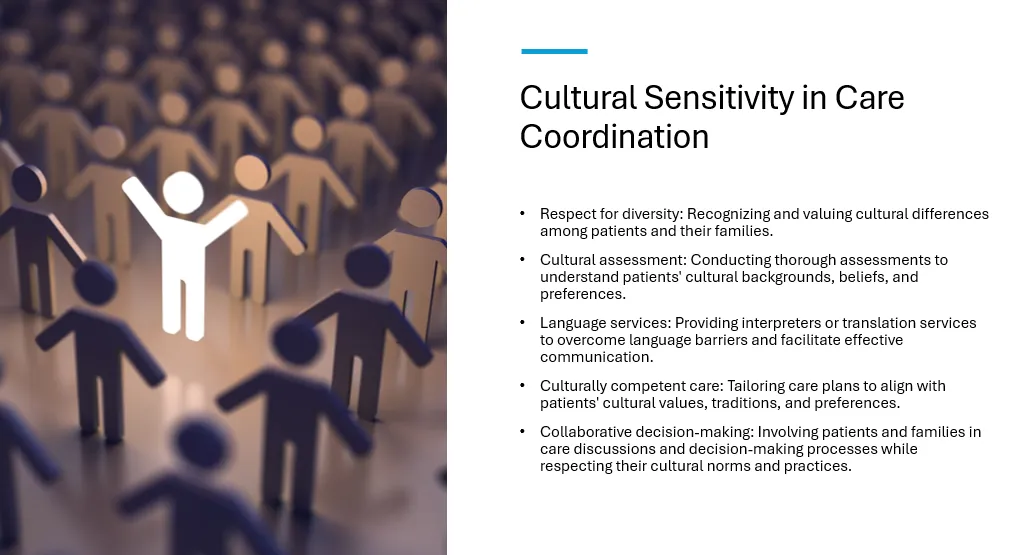
Identify the potential impact of specific healthcare policy provisions on outcomes and patient experiences.What are the logical implications and consequences of relevant policy provisions?What evidence do you have to support your conclusions?
Potential Impact of Health Care Policy Provisions on Outcomes and Patient Experiences
For this section of the NURS 4050 Assessment Three, we will explore the potential impact of healthcare policies on patients’ experiences.
1. Analyze Relevant Health Care Policies
- Identify key healthcare policies that affect patient-centered care.
- Discuss these policies’ logical implications and consequences on patient outcomes and experiences.
- Support your analysis with evidence from scholarly sources.
Example
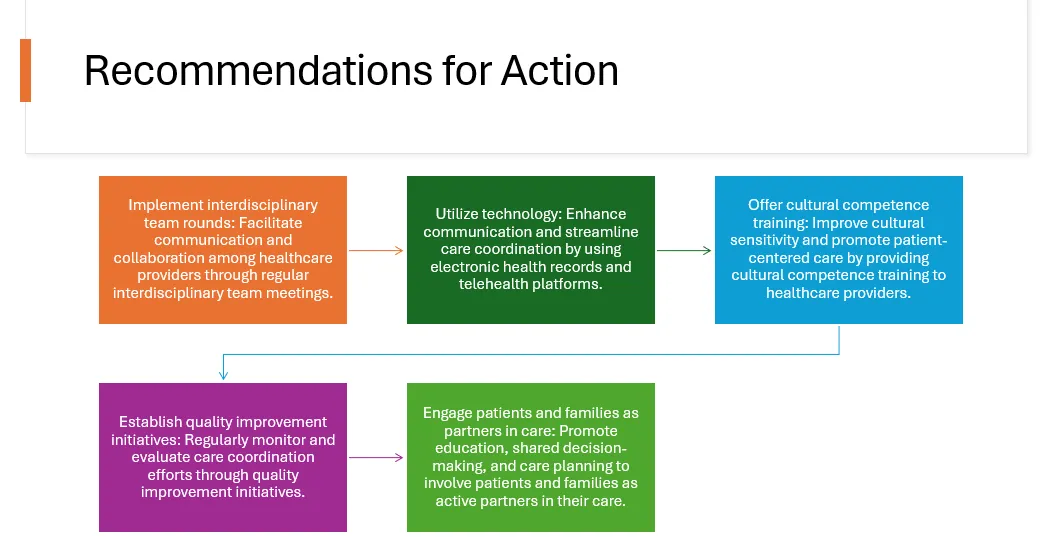
2. Policy Advocacy and Implementation
- Highlight the importance of nurse involvement in policy advocacy.
- Provide strategies for effectively implementing policy changes within your practice.
Example
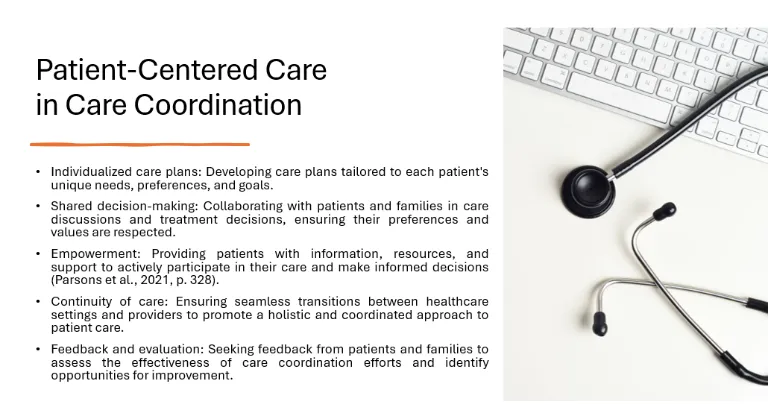
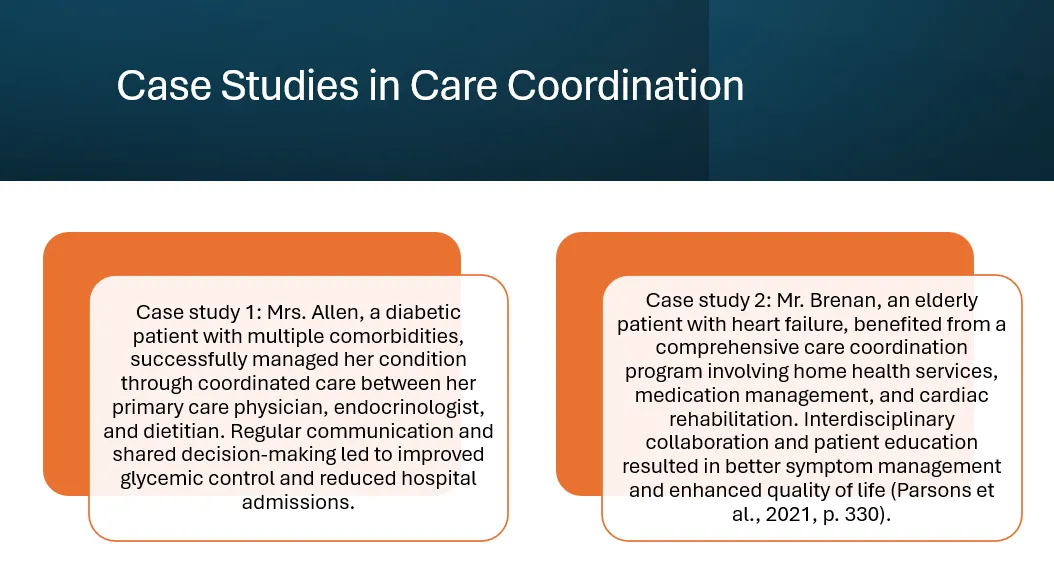
In a video-recorded presentation, raise awareness of the nurse’s vital role in the coordination and continuum of care.Fine-tune the presentation to your audience.Stay focused on key issues related to the effects of resources, ethics, and policy on the provision of high-quality, patient-centered care.Adhere to presentation best practices.
Raising Awareness of the Nurse’s Role in Care Coordination
We will discuss raising awareness of the nurses’ role in care coordination.
1. Emphasize the Nurse’s Vital Role
- Highlight the critical role nurses play in coordinating and managing patient care.
- Discuss the impact of effective care coordination on patient outcomes and satisfaction.
2. Tailor Your Presentation to Your Audience
- Fine-tune your presentation to meet the needs and interests of your nursing colleagues.
- Stay focused on key issues related to resources, ethics, and policy in patient-centered care.
Example
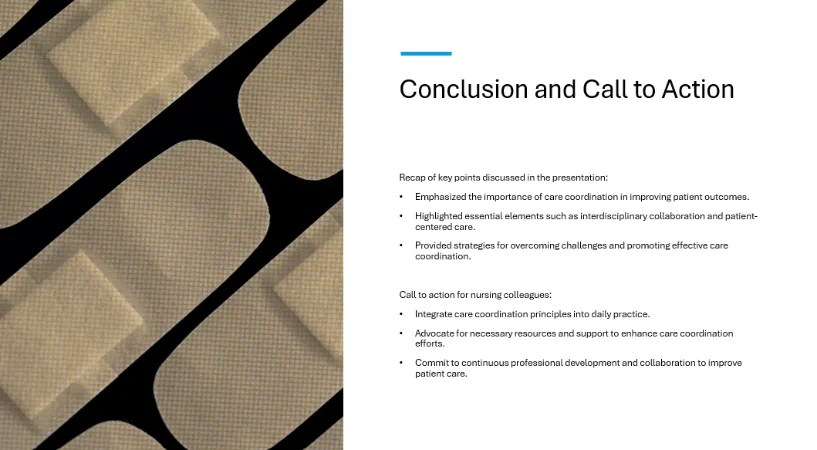
Presentation Best Practices
1. Preparation and Rehearsal
- Allow ample time to prepare and rehearse your presentation.
- Ensure your content is well-organized and engaging.
2. Visual and Verbal Communication
- Use clear and concise language supported by visual aids such as slides or infographics.
- Maintain a professional tone and practice good public speaking skills.
Demonstration of Proficiency
Competency 2: Collaborate with patients and families to achieve desired outcomes.
Competency 3: Create a satisfying patient experience.
Competency 4: Defend decisions based on the code of ethics for nursing.
Competency 5: Explain how healthcare policies affect patient-centered care.
Competency 6: Apply professional, scholarly communication strategies to lead patient-centered care.
Closing
The NURS-FPX 4050 Assessment Three: Care Coordination Presentation to Colleagues aims to equip you with the skills and knowledge necessary to educate your peers on the fundamentals of care coordination. Following this How-To Owlisdom Guide, you can develop a comprehensive and engaging presentation addressing key aspects of care coordination, change management, and ethical decision-making. Remember, the goal is to enhance the care coordination process and improve patient outcomes within your community care center. With careful preparation and attention to detail, you can effectively convey the importance of coordinated care and the nurse’s role in this critical process.
NURS-FPX 4050 Assessment Four: Final Care Coordination Plan
Instructions for NURS-FPX 4050 Assessment Four
Final Care Coordination Plan
This course has been completed and no further assessments may be submitted.
For this assessment, you will evaluate the preliminary care coordination plan you developed in Assessment 1 using best practices found in the literature.
Collapse All
Introduction
This assessment provides an opportunity to research the literature and apply evidence to support what communication, teaching, and learning best practices are needed for a hypothetical patient with a selected health care problem.
NOTE: You are required to complete this assessment after Assessment 1 is completed.
Preparation
You are encouraged to complete the Vila Health: Cultural Competence activity before completing this assessment. Completing course activities before submitting your first attempt has been shown to make the difference between basic and proficient assessment.
In this assessment, you will evaluate the preliminary care coordination plan you developed in Assessment 1 using best practices found in the literature.
To prepare for your assessment, you will research the literature on your selected health care problem. You will describe the priorities that a care coordinator would establish when discussing the plan with a patient and family members. You will identify changes to the plan based upon EBP and discuss how the plan includes elements of Healthy People 2030.
Instructions
Note: You are required to complete Assessment 1 before this assessment.
For this assessment:
- Build on the preliminary plan, developed in Assessment 1, to complete a comprehensive care coordination plan.
Document Format and Length
Build on the preliminary plan document you created in Assessment 1. Your final plan should be a scholarly APA-formatted paper, 5–7 pages in length, not including title page and reference list.
Supporting Evidence
Support your care coordination plan with peer-reviewed articles, course study resources, and Healthy People 2030 resources. Cite at least three credible sources.
Grading Requirements
The requirements, outlined below, correspond to the grading criteria in the Final Care Coordination Plan Scoring Guide, so be sure to address each point. Read the performance-level descriptions for each criterion to see how your work will be assessed.
- Design patient-centered health interventions and timelines for a selected health care problem.
- Address three health care issues.
- Design an intervention for each health issue.
- Identify three community resources for each health intervention.
- Consider ethical decisions in designing patient-centered health interventions.
- Consider the practical effects of specific decisions.
- Include the ethical questions that generate uncertainty about the decisions you have made.
- Identify relevant health policy implications for the coordination and continuum of care.
- Cite specific health policy provisions.
- Describe priorities that a care coordinator would establish when discussing the plan with a patient and family member, making changes based upon evidence-based practice.
- Clearly explain the need for changes to the plan.
- Use the literature on evaluation as a guide to compare learning session content with best practices, including how to align teaching sessions to the Healthy People 2030 document.
- Use the literature on evaluation as guide to compare learning session content with best practices.
- Align teaching sessions to the Healthy People 2030 document.
- Apply APA formatting to in-text citations and references, exhibiting nearly flawless adherence to APA format.
- Organize content so ideas flow logically with smooth transitions; contains few errors in grammar/punctuation, word choice, and spelling.
RESOURCES
Use the resources linked below to help complete this assessment.
Collapse All
Managing Chronic Illnesses
Read through the resource on the following reading list to identify the role of care coordination in managing chronic illnesses. Pay close attention to similarities between your community and the patient population:
- Assessment 4: Managing Chronic Illnesses reading list.
Academic Resources
A variety of writing resources are available in the NHS Learner Support Lab, linked in the courseroom navigation menu.
Scholarly Writing and APA Style
Use the following resources to improve your writing skills and find answers to specific questions.
Library Research
Use the following resources to help with any required or self-directed research you do to support your coursework.
- BSN Program Library Research Guide.
- Capella University Library.
- Journal and Book Locator Library Guide.
- Library Research and Information Literacy Skills.
ePortfolio
Use the following resource to understand how to save your assessments to ePortfolio:
Additional Resources for Further Exploration
You may use the resource on the following reading list to further explore topics related to the competencies. Consider how health care scientists assess and evaluate a diverse cultural setting and the impact on needed health care.
ACTIVITY
Cultural competence is a skill set for care coordinators that is crucial to the provision of patient-centered care and satisfying patient experiences. Each individual comes with a unique set of cultural experiences and an identity shaped by their cultural upbringing. Even if a patient comes from a similar background as you, their cultural background may be completely different. If patients come from a very diverse background, you must still approach their care by identifying and prioritizing their unique cultural needs. Often, nurses will focus on treating all patients the same. However, we know that from a cultural and even biological standpoint, treating all patients the same may result in harm. Because nurses are to provide care without harm, cultural competence is a necessary skill.
Complete the Vila Health: Cultural Competence activity to gain insight into the implications for a safe and effective continuum of care and the potential consequences when culturally competent care is lacking.
This tool needs to be loaded in a new browser window
Introduction to NURS-FPX 4050 Assessment Four: Final Care Coordination Plan
The nurse's fpx 4050 assessment 4 : Final Care Coordination Plan aims to guide you through evaluating and improving a preliminary care coordination plan. By leveraging best practices in the literature, students will enhance their ability to communicate, teach, and learn effectively in patient-centered care settings. This How-To NURS 4050 Guide will provide a structured approach to designing health interventions, considering ethical implications, understanding health policies, and aligning with the Healthy People 2030 objectives.
Design patient-centered health interventions and timelines for a selected healthcare problem. Address three healthcare issues . Design an intervention for each health issue. Identify three community resources for each health intervention.
Designing Patient-Centered Health Interventions and Timelines
To start the NURS-FPX 4050 Assessment Four: Final Care Coordination Plan, we will address healthcare issues.
- Identify three specific healthcare issues relevant to your selected healthcare problem.
- Use literature to support why these issues are critical for patient care.
- Create an evidence-based intervention for each identified healthcare issue.
- Ensure each intervention is tailored to the patient’s needs and preferences.
- Find three community resources for each health intervention.
- Verify the reliability and accessibility of these resources for your patient.
Example
The draft care coordination plan identified three primary healthcare issues: medication management, access to specialist care, and lifestyle modification. For medication management, interventions might include a medication adherence program, educating patients on proper medication usage, and providing medication reconciliation services. Examples of community resources include local pharmacies offering prescription delivery, medication synchronization services, and medication management support groups. Improving access to specialist care might involve simplifying the referral process, arranging transportation to appointments, and educating patients on the importance of follow-up care. Community resources for this include specialty clinics, patient navigation programs, and telehealth services for remote consultations (Eastman et al., 2022, p. 2430). For lifestyle modification, interventions could include creating personalized diet and fitness plans, offering counseling, and organizing group wellness activities. Community resources include fitness centers, dietitians, and community health education programs.
Consider ethical decisions in designing patient-centered health interventions. Consider the practical effects of specific decisions. Include the ethical questions that generate uncertainty about the decisions you have made.
Ethical Considerations in Designing Health Interventions
Here, we will discuss the ethical considerations of the decision-making process.
- Assess how each intervention decision practically impacts patient care and outcomes.
- Consider the feasibility and potential barriers to implementing these decisions.
- Identify ethical questions that arise from your intervention decisions.
- Discuss uncertainties and how they can be addressed through ethical frameworks.
Ethical considerations are crucial when designing patient-centered health interventions for care coordination. This involves ensuring that treatments uphold beneficence, non-maleficence, justice, and patient autonomy. For instance, respecting patient autonomy requires involving patients in decision-making and obtaining informed consent. However, making ethical decisions can also present real-world challenges and uncertainties. Examples include balancing the benefits and risks of treatments, ensuring equitable access to resources, and navigating cultural or religious beliefs that may affect treatment choices (Mirza et al., 2022, p. 1927). Addressing these issues requires professional judgment, adherence to ethical standards, and careful consideration of each patient’s preferences. Care coordinators must navigate ethical dilemmas with sensitivity, empathy, and a commitment to promoting patients’ well-being while respecting their rights and values.
Identify relevant health policy implications for the coordination and continuum of care.Cite specific health policy provisions.
Relevant Health Policy Implications of NURS-FPX 4050 Assessment Four: Final Care Coordination Plan
For this section of the NURS-FPX 4050 Assessment Four: Final Care Coordination Plan, we will explore the healthcare provision\
Health Policy Provisions
- Research relevant health policies that impact your care coordination plan.
- Cite specific provisions and explain how they influence patient care continuity and coordination.
Example
Health policies significantly influence the continuum of care and care coordination. They identify relevant policies related to insurance coverage, reimbursement procedures, and quality standards. For instance, laws like the Affordable Care Act (ACA) impact access to healthcare services, affecting care coordination initiatives. Understanding these provisions’ effects on patient outcomes, resource allocation, and healthcare delivery is essential. Evidence and literature highlight how policies influence patient experiences, care coordination practices, and healthcare disparities. By analyzing policy implications, care coordinators can better navigate regulatory requirements, advocate for necessary changes, and ensure compliance with ethical standards and best practices (Mirza et al., 2022, p. 1929). Addressing health policy implications ultimately enhances the effectiveness and efficiency of care coordination efforts, improving patient outcomes and overall care quality.
Describe priorities a care coordinator would establish when discussing the plan with a patient and family member, making changes based on evidence-based practice. Clearly explain the need for changes to the plan.
Establishing Priorities in Care Coordination
Here, we will discuss establishing communication with the patients and their families.
- Determine key priorities when discussing the care plan with the patient and family.
- Use best practices in communication to ensure clarity and understanding.
- Identify changes to the care plan based on recent evidence-based practices.
- Justify the need for each change and its anticipated impact on patient outcomes.
Example
When discussing the care coordination plan, it is crucial to prioritize understanding patients’ and families’ preferences, addressing their immediate concerns, and establishing clear communication channels. Involving patients and families in decision-making ensures that the care plan reflects their needs and preferences. Promoting patient participation and adherence to the plan also requires providing education and support to enhance health literacy and self-management skills. Evidence-based adjustments to the care coordination plan might include introducing new therapies, modifying existing ones, or altering the schedule to align with the latest scientific findings and clinical guidelines. These evidence-based changes aim to optimize patient outcomes, improve care efficiency, and elevate the overall quality of care delivery (Mirza et al., 2022, p. 1941). By incorporating evidence-based modifications, care coordinators ensure the plan remains up to date with best practices in healthcare and adaptable to evolving patient needs.
Use the literature on evaluation as a guide to compare learning session content with best practices, including how to align teaching sessions to the Healthy People 2030 document. Use the literature on evaluation as a guide to compare learning session content with best practices.
Evaluating Learning Sessions Against Best Practices
Now, we will evaluate the learning sessions against the best practices.
- Compare your learning session content with best practices found in the literature.
- Highlight strengths and areas for improvement.
- Ensure your teaching sessions align with the objectives and goals of Healthy People 2030.
- Discuss how your sessions contribute to these broader public health goals.
Example
Evaluating the lesson plan content using literature on best practices is essential for ensuring effective teaching sessions. Comparing the material to established best practices allows educators to identify areas for improvement, refine their methods, and ensure their sessions align with evidence-based recommendations. Additionally, integrating the principles of the Healthy People 2030 document into teaching activities addresses public health priorities. It supports achieving national health objectives (Office of Disease Prevention and Health Promotion, 2024). By incorporating relevant Healthy People 2030 goals and objectives, educators can enhance population health outcomes and address significant health disparities. This alignment ensures that teaching sessions are educationally effective and meet key national public health goals and priorities.
Closing
By following this How-To Owlisdom Guide, you will develop a comprehensive, patient-centered care coordination plan that incorporates best practices, ethical considerations, and relevant health policies and aligns with Healthy People 2030. The key takeaways from the NURS-FPX 4050 Assessment Four: Final Care Coordination Plan include the importance of evidence-based interventions, ethical decision-making, effective communication, and continuous evaluation against established best practices to enhance patient care outcomes.



